Aviation against tanks (part of 11)
By the beginning of World War II, there were no serial attack aircraft in the UK and the USA capable of effectively fighting the German tanks. The experience of military operations in France and North Africa has shown the low efficiency of fighters and bombers in service when used against armored vehicles. So, during the battles in North Africa, the squadron of British Blenheim Mk I bombers, provided that each aircraft was loaded with four 113 kg high-explosive bombs, could destroy or seriously damage 1-2 enemy tanks. At the same time, because of the danger of destruction by fragments of their own bombs, bombing was carried out from horizontal flight from a height of at least 300 meters. The best results were predictably achieved when striking at places of accumulation of tanks and columns of armored vehicles. Tanks deployed in battle formations were not vulnerable to bombers. Allied fighters with machine gun and cannon weapons of 12,7-20 mm caliber also proved to be practically powerless against German medium tanks and self-propelled guns.
By the end of 1941, it became clear that the British Hurricanes in Africa were not able to fight the German Messerschmitt Bf 109F and the Italian Macchi C.202 Folgore on equal terms, and were reclassified as fighter-bombers. Although in some cases, pilots fighter Hurricane Mk IIС with four aviation Hispano Mk II cannons managed to disable Italian wedges and armored cars, the effectiveness of such attacks was low. As practice has shown, even when breaking through relatively thin armor, the armor effect of 20-mm shells was weak and, as a rule, they did not cause serious damage. In this regard, on the basis of the "tropical" modification of the Hurricane IIB Trop, a strike version of the Hurricane IID was created, armed with two 40-mm Vickers S guns with an ammunition of 15 shells per barrel. Before firing cannons, two 7,7 mm Browning .303 Mk IIs with tracer bullets could be used for shooting. The combat use of aircraft with 40 mm guns as part of the 6th RAF squadron began in mid-1942.
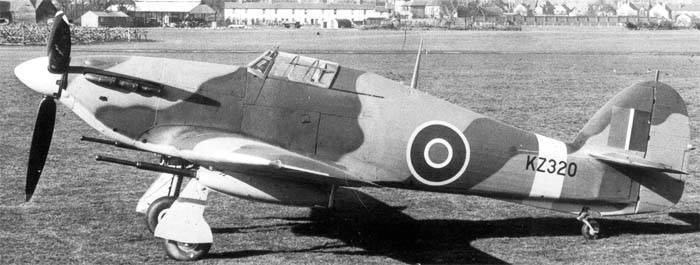
Since the "artillery" fighter had to operate mainly on the ground, to protect against anti-aircraft fire, the cockpit and a number of the most vulnerable points of the aircraft were partially covered with armor. Additional load in the form of body armor and guns weighing 134 kg worsened the already not too high flight data of the Hurricane.
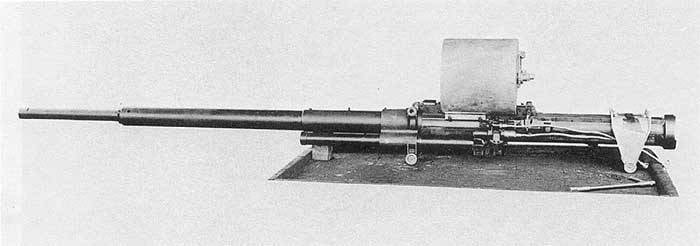
Following Hurricane IID, Hurricane IIE appeared. On this plane, the 40-mm guns were housed in removable gondolas. Instead of them, eight RP-60 3-pounders could be suspended, in addition to which there were two built-in 7,7 mm Browning .303 Mk II machine guns. Instead of guns and missiles, the aircraft could carry two outboard fuel tanks or two 250 pound (113 kg) bombs. It was impossible to use cannons and rockets under different wings, because of the recoil when firing, the rockets fell from the guides. In order to reduce the vulnerability to the shelling from the ground, the Hurricane IIE reservation was further strengthened. Now not only the cabin and the radiator were exposed to protection, armor also appeared on the sides of the engine. To compensate for the drop in flight data due to the increased take-off weight of the aircraft, the Merlin 27 engine, 1620 hp, was installed on the aircraft. This model received the designation Hurricane Mk IV.
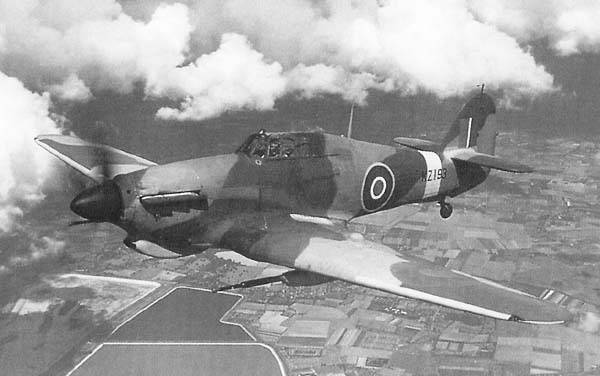
The aircraft with a maximum take-off weight of 3840 kg had a practical range of 640 km. When installing two outboard fuel tanks with a total capacity of 400 L, the flight distance increased to 1400 km. The maximum speed was 508 km / h, cruising - 465 km / h.
Despite its low characteristics, the serial production of the Hurricane percussion continued until the beginning of 1944. For lack of better, they were actively used against ground targets in the African campaign. At the request of the British, during the five-day battle at El Alamein, which began in the evening 23 October 1942 years, six squadrons of "Hurricane" fighter-bombers during 842 sorties destroyed 39 tanks, more than 200 APCs and trucks, 26 tank trucks with fuel and 42 artillery guns. Own losses in the technology were not disclosed, but it is known that during the execution of the assault airstrikes, 11 British pilots were killed.
Pilots who flew in Hurricanes with 40-mm cannons in North Africa announced the destruction of 47 tanks and roughly 200 units of other vehicles. Since June 1943, the "artillery" attack aircraft began to operate in Europe. If in Africa the main targets were armored vehicles, in Europe they were mainly hunting for locomotives. At the start of the 1944, attack aircraft were used against the Japanese in Burma. Since there were relatively few tanks in the Japanese army, fighter-bombers, using mostly fragmentation 40-mm shells, operated on transport communications and sank small vessels in the coastal zone. In combat missions from 700 "Hurricanes" with 40-mm guns, about a third of attack aircraft were lost, even taking into account local reservations, the plane was very vulnerable to anti-aircraft fire.
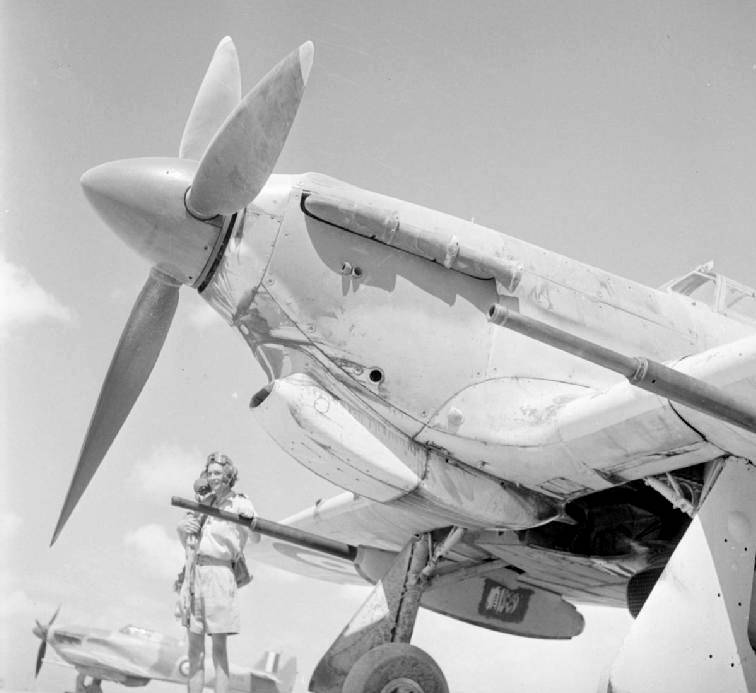
Although the British claimed that the effectiveness of firing at tanks was 25%, in reality even very experienced pilots managed to get into the 1-2 tank with shells at best. The British aircraft had the same flaw as on the IL-2 with the 37-mm guns - due to strong recoil, aimed shooting was possible only with a shot length of 2-3. Sighting shooting at a single tank was recommended to open from a distance 500-400 m. In addition, the reliability of the gun Vickers S left much to be desired. Delays and failures in shooting occurred in every 3-4 combat departure. As in the case of the Soviet NA-37, aimed fire from one large-caliber gun in the event of failure of the other was impossible - the plane turned and only one projectile was flying towards the target.
An 40-mm armor-piercing projectile with a mass of 1113 g left the gun barrel with a length of 1,7 m at a speed of 570 m / s, and at a distance of 300 m normal pierced through an 50 mm armor plate. Theoretically, such an indicator of armor penetration allowed us to confidently fight medium German tanks when firing at the side or from the stern. However, in practice, it was impossible to get into the armor of a tank at a right angle from a hollow diving plane. Under these conditions, shells often ricocheted, but even in the case of armor penetration, the destructive effect was usually small. In this regard, "Hurricane" with "big guns" did not become an effective anti-tank tool.
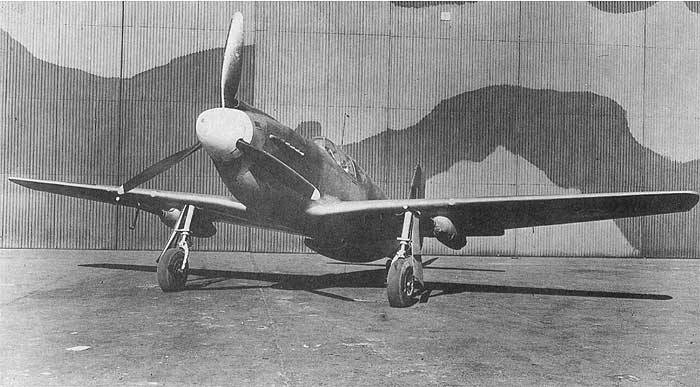
By the beginning of 1944, the Allies realized the futility of creating specialized anti-tank attack aircraft with cannon armament. Although it is known that the Americans also tested the assault version of the Mustang with 40-mm cannons Vickers S. The crushing return of large-caliber aircraft cannons did not allow acceptable accuracy of firing more than 2-3 with projectiles in the queue, the ammunition for such guns was very limited, and large Mass and significant frontal resistance of large-caliber guns worsened flight performance. On the basis of Vickers S, it was planned to create an 57-mm aircraft gun with armor penetration to 100 mm, but calculations showed that such a weapon would have excessive mass and unacceptably strong recoil for use on single-engine fighter-bombers, and work in this direction was curtailed.
The basic one weapons American fighters during the Second World War were 12,7-mm machine guns, ineffective even against light armored vehicles. 20-mm guns were installed quite rarely and by their characteristics of armor penetration they differed little from heavy machine guns. However, in the prewar period, American designers experimented with larger-caliber aircraft guns, and a number of combat aircraft with 37-75-mm guns were created in the United States, but their main purpose was not to fight armored vehicles.
So, the 37-mm M4 cannon with 30 ammunition of shells was armed with the P-39D Airacobra fighter. The 97 kg cannon had a 150 shot rate / rpm. The fighter’s ammunition, as a rule, included fragmentation shells. An 750 g armor-piercing projectile left the barrel at an initial speed of 610 m / s and could penetrate 25 mm armor at a distance of 400 m. But the AeroCab pilots used guns mainly in air battles, and only occasionally for shelling ground targets.
75-mm gun M5 with manual loading, weight 408 kg was installed on the B-25G Mitchell bombers. An armor-piercing projectile weighing 6,3 kg with an initial speed of 619 m / s at a distance of 300 m along the normal pierced through 80 mm homogeneous armor. A gun with such armor penetration could surely hit medium tanks PzKpfw IV.

But given the fact that during the attack, in view of the extremely low rate of fire, one tank could be fired at a real distance of a battle, the strength of two shots was very low from the strength of two shots. They tried to improve accuracy by shooting tracer bullets from 12,7-mm machine guns, but the effectiveness of firing at small targets remained small. In this connection, the Mitchells, armed with 75-mm guns, were used mainly in the Pacific against Japanese ships of small and medium displacement. When attacking large sea convoys, the B-25G effectively suppressed anti-aircraft fire. When firing from the 1500 distance m, the crew of the assault Mitchell managed to make an 3-4 sighting shot at the destroyer class ship.
At the beginning of 1942, the designers of the American company North American began to create a diving bomber based on the P-51 Mustang fighter. The first "Mustangs" in February 1942, the British used in battle. The fighter, known as the Mustang I, proved to be a very easy-to-operate and highly maneuverable aircraft. However, the Allison V-1710-39 engine, installed on the first Mustangs, had a significant disadvantage - after rapidly gaining more than 4000 meters, it rapidly lost power. This significantly reduced the combat value of the aircraft, while the British needed fighters capable of confronting the Luftwaffe at medium and high altitudes. Therefore, the entire batch of American-made fighter aircraft was transferred to tactical aviation units, which were subordinate to the Tactical Command for interaction with army units, but there was no need for a high altitude. British pilots who flew on the Mustang I, mainly engaged in low-altitude photography, free hunting on railways and highways and attacked point ground targets along the coast. Later, the number of their tasks was introduced by the interception of single German aircraft trying at low altitude, out of sight of British radar, to break through and strike targets in the UK. Given the success of the low-altitude Mustang I fighters, in April 1942, North American was given an order to create a pure strike aircraft that could drop bombs from a dive. Total supposed to build 500 aircraft. The shock version of the "Mustang" received the designation A-36A and proper name Apache.
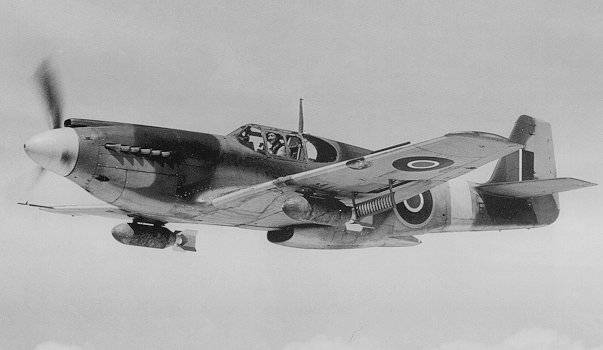
On the A-36, an Allison 1710-87 engine with an 1325 hp power was installed, which allowed it to reach speed in horizontal flight 587 km / h. The aircraft with a maximum take-off weight of 4535 kg had a range of 885 km. Built-in weapons consisted of six 12,7-mm machine guns. The combat load initially consisted of two 227 kg (500-pounder) bombs, and in the future, incendiary tanks began to be suspended from napalm.
Since the "Mustang" from the very beginning had excellent aerodynamics, the aircraft developed a high speed during a dive, which was not necessary for a diving bomber. To reduce the maximum speed of a dive on the plane, they installed perforated brake flaps, reducing speed to 627 km / h.
The first A-36A in June 1942 of the year entered service with the 27-th light bomber group and the 86-th group of diving bomber operating in Italy. In July, the bomber groups began to perform the first combat missions, launching attacks against targets in Sicily. After a month of combat use, the pilots of the two groups made more than 1000 sorties. In August 1943, both groups were renamed Fighter-Bomber. American dive bombers had a significant impact on the course of hostilities in Italy. Due to the not very suitable bomb armament against tanks deployed in battle formations, the Apaches were ineffective, but on the other hand they were very successful at armored vehicles and transport convoys. The main role of A-36A in the fight against tanks was to destroy bridges and destroy mountain roads, which made the terrain impassable for armored vehicles and made it difficult for German tank units to bring fuel and ammunition. In the middle of September 1943, the A-36A and P-38 fighter-bombers provided almost decisive assistance to the units of the US 5 Army in the Apennines, which were in a very difficult situation. Thanks to a series of successful strikes against the concentration points of the enemy forces, bridges and communications, the offensive outburst of the German forces was stopped.
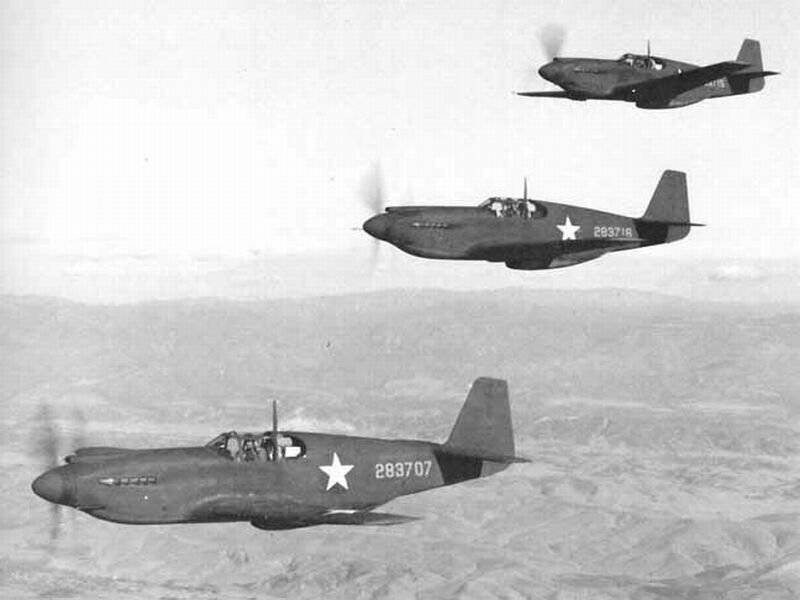
Initially, the main combat technique "Apache" was dive-bombing. Usually, the sorties were made as part of the 4-6 group of airplanes, which alternately swooped on the target from a height of 1200-1500 m, while the accuracy of the bombing was quite high. After dropping bombs, the target was often fired with machine guns, thus making 2-3 combat approaches. It was believed that the guarantee of the Apache invulnerability was their high speed, but with such tactics the anti-aircraft gunners had time to react and target, and the losses of the dive bombers were very significant. In addition, when diving at high speeds, the aircraft very often became unstable, which was due to the abnormal operation of the aerodynamic brakes.
To reduce losses, it was decided to drop all the bombs in one go, and to increase stability, bombing was carried out from a flatter dive angle and from a greater height. This made it possible to reduce losses, but the accuracy of the bombing dropped significantly. The combat effectiveness of A-36A against tanks could be significantly higher when using incendiary tanks with napalm. But incendiary tanks with A-36A were used mainly against the Japanese, in the jungles of Burma.
In total, the Apaches in the Mediterranean and Far Eastern theaters of military operations made 23373 sorties, during which more than 8000 tons of bombs were dropped. In A-36A air battles, the enemy's 84 aircraft were destroyed. Own losses were 177 units. Most of the downed shock "Mustangs" fell on the 20-37-mm caliber anti-aircraft guns during re-entry missions. The A-36A combat career actually ended in the first half of 1944, when more advanced American fighters P-51D Mustang, P-47 Thunderbolt, as well as the British Typhoon and Tempest began to enroll in combat squadrons.
The main anti-tank weapons of British and American fighter-bomber steel missiles. The first British unguided RP-3 aircraft missiles were based on 76,2-mm anti-aircraft missiles. The British three-inch anti-aircraft missile was a simple tubular structure with stabilizers, the engine used 5 kg cord cord brand SCRK. The first aircraft missiles were tested on the Hurricane and Beautifier.
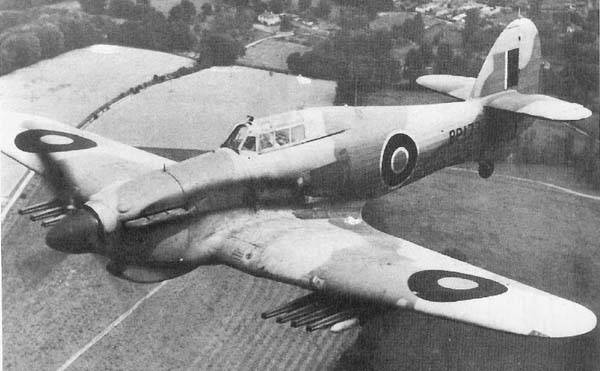
Initially, the 87,3 mm (3,44 inch) steel-launched rockets were designed to combat the German submarines that surfaced and were periscope depths. On tests, it turned out that a monolithic steel warhead weighing 11,35 kg at a distance of 700 meters can penetrate an 3-inch steel plate. It was more than enough to break through the solid hull of a submarine and allowed to confidently fight with medium tanks. The target launch range was limited to 1000 meters, the maximum flight speed of the rocket was 440 m / s. There is also evidence of the creation of an 87,3-mm rocket, the warhead of which contained a hard-alloy core. But whether they were used in hostilities, information could not be found.
In June, 1942, armor-piercing missiles began to be actively used by British fighter-bombers in North Africa. According to reports of British pilots, with a salvo launch of missiles on a single tank, it was possible to achieve hits in 5% of cases. The result, of course, was not high, but in any case, the effectiveness of the missiles was higher than during the shelling of 20-mm guns. Due to low accuracy, when it was possible, NAR launches tried to carry out armored vehicles in places of congestion and columns.
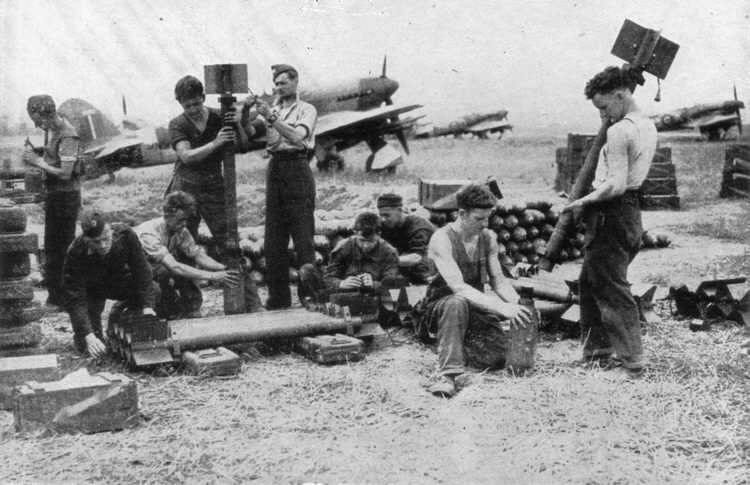
For use against "non-solid" targets, a high-explosive 114-mm (4,5 inch) warhead was created, a warhead weighing 21,31 kg, containing 1,36 kg of TNT-hexogen alloy. It is worth saying that for the family of British aircraft missiles used a single "chassis" with stabilizers and a cruise engine equipped with a cordit. The rockets and the spinning warheads themselves were delivered to the airfields of the fighter-bombers separately, and could be completed depending on the specific combat mission.
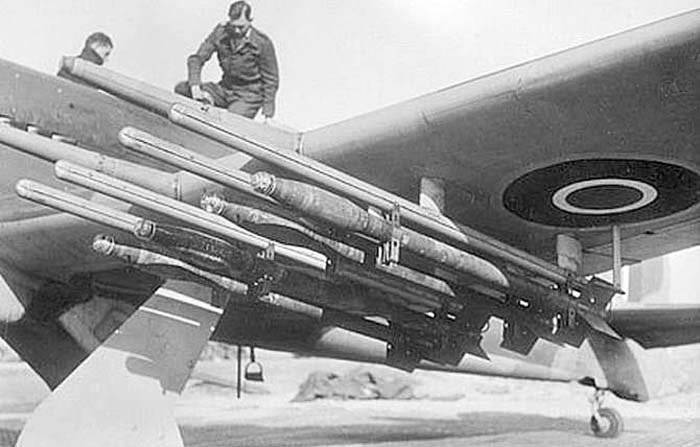
Missiles with high-explosive fragmentation warhead proved to be effective not only against trains, transport convoys, anti-aircraft batteries and other areal targets. In some cases, with their help, it was possible to successfully fight with German armored vehicles. The 1,36 kg of powerful explosives, enclosed in a robust case 4 mm thick, in the case of a direct hit turned out to be enough to break through the 30-35 mm armor. In this case, not only armored personnel carriers were vulnerable, but also medium German tanks. The armor of heavy tanks with these missiles did not penetrate, but the NAR hit, as a rule, did not pass without a trace. Even if the armor was able to withstand, observation devices and sights often suffered, the attachments were swept away, the turret was jammed, the gun and the undercarriage were damaged. In most cases, tanks hit by high-explosive high-explosive artillery missiles lost their combat capability.
There was also a rocket with a 114-mm warhead equipped with white phosphorus. Attempts to use incendiary missiles against armored vehicles turned out to be ineffective in most cases - when they hit armor, white phosphorus burnt out, without causing any special harm to combat vehicles. Incendiary shells were a threat to trucks or open-top armored personnel carriers, towing vehicles, tanks with open hatches during loading of ammunition or refueling. In March, 1945, the missiles with improved accuracy and cumulative combat units, but the British did not have time to use them in battle.
In the second half of 1942, it became known that heavy tanks appeared in Germany, after which the question arose of building missiles capable of penetrating their armor. In 1943, a new version of the missile with an 152-mm armor-piercing high-explosive warhead (semi-armored in British terminology - Eng. Semi Armor Piercing) was put into service. Warheads weighing 27,3 kg with a strong armor-piercing tip contained 5,45 kg of explosives were able to penetrate 200 mm armor and had a good fragmentation effect. At a distance of 3 meter heavy fragments punched 12 mm armor plate. Due to the fact that the rocket engine remained the same, and the mass and frontal resistance increased significantly, the maximum velocity of the missile dropped to 350 m / s. In this regard, there was a slight drop in the launch range and the shooting accuracy deteriorated, which was partially offset by an increased destructive effect.

According to British data, 152-mm missiles confidently hit heavy tanks Pz.Kpfw.VI Ausf.H1. However, the British pilots tried to attack the Tigers and Panthers on board or from the stern, which indirectly indicates that the frontal armor of German heavy tanks, due to the likelihood of a rebound, could not always be broken through. If, as a result of a direct hit, penetration did not occur, the tank, as a rule, still received heavy damage, the crew and internal units were often hit by internal chipping of armor.
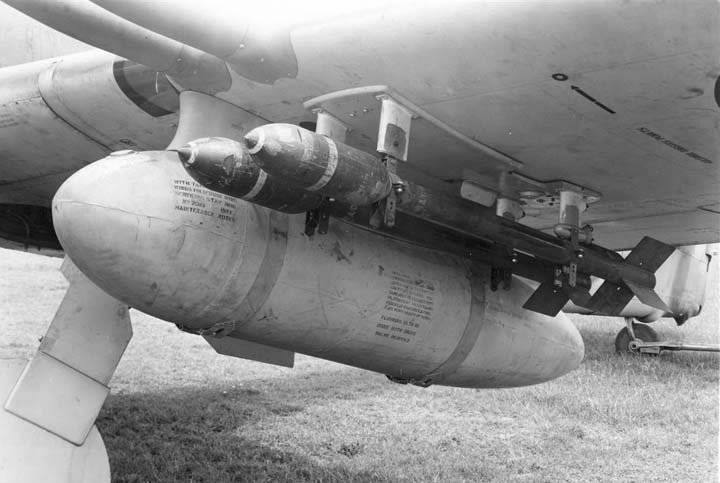
Thanks to a powerful warhead, the undercarriage was destroyed at close break, optics and armament were knocked out. It is believed that the cause of death of Michael Wittman - one of the most famous German tank aces, was hit in the rear part of his "Tiger" missiles from the British fighter-bomber "Typhoon". Heavy 152-mm missiles were also successfully used against German ships, trains, military columns and artillery positions. There are cases when small bridges were destroyed by a missile salvo, which hampered the advancement of German tanks.
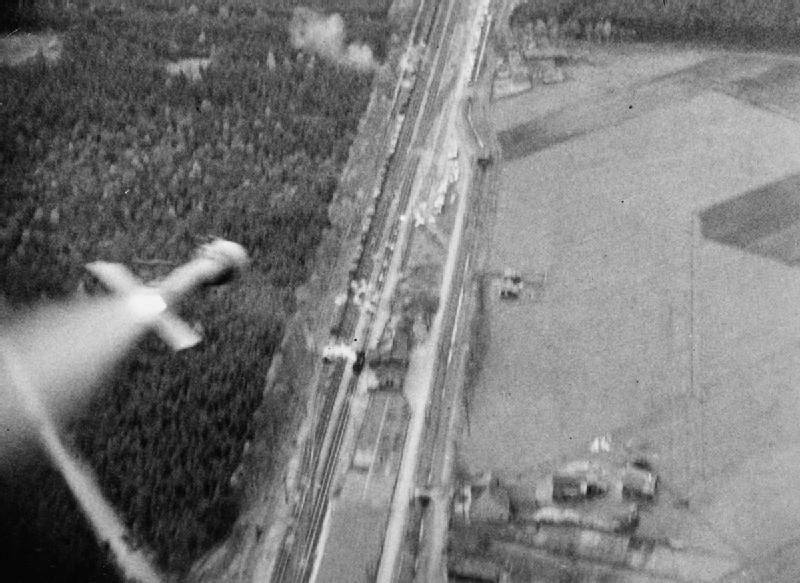
By the end of 1942, aircraft missiles were being released in large quantities. The British NARs were very primitive and did not differ in high accuracy, but their advantages were high reliability and low cost of production.
After the Typhoon fighters were attracted to strikes on ground targets, the missiles took a firm place in their arsenal. The standard option was to install eight guides, four under each wing. The Typhoon fighters-bombers of the Hauker Company made their first combat sorties against ground targets in November 1942 of the year. Although the Typhoon was not equipped with powerful armor, it turned out to be quite tenacious. Its success in the role of a fighter-bomber contributed to good low-altitude handling and powerful weapons: four 20-mm cannons, eight NAR or two 1000-pound (454 kg) aerial bombs. The practical range of the flight with rockets was 740 km. Maximum speed without external hangers on the ground - 663 km / h.
By the end of 1943, the Typhoon aviation units capable of carrying missiles from 18 formed the Second Tactical Command of the RAF, whose main task was the direct air support of ground forces, the fight against fortifications and enemy armored vehicles.
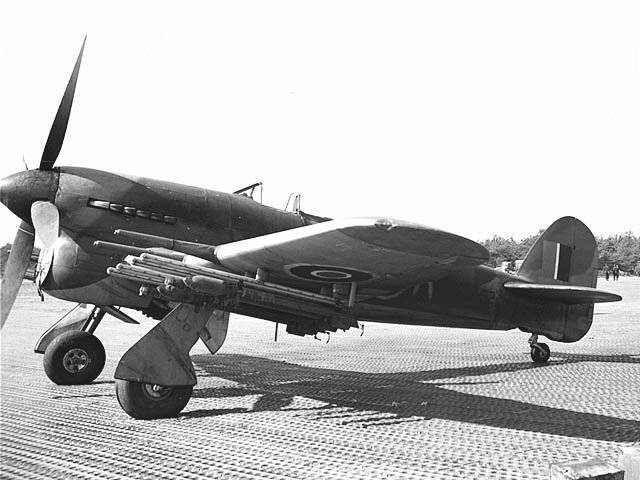
After the Allies landed in Normandy, the Typhoons conducted a free hunt in the nearby German rears or patrolled near the front line at an altitude of about 3000. After receiving an aircraft engineer command on the radio, they attacked armored vehicles, gun emplacements or mortar positions on the battlefield. At the same time, the target was “tagged” with smoke shells or signal rockets, if possible.
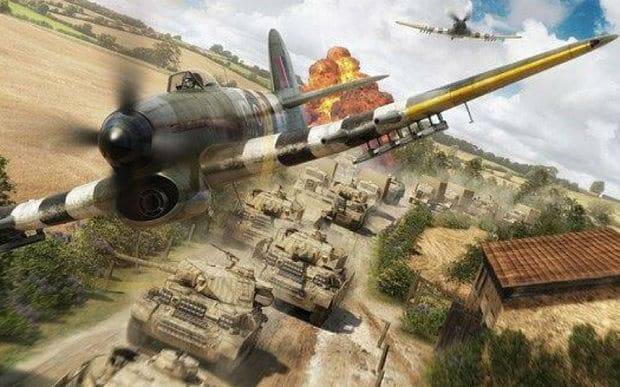
With the opening of the "Second Front" one of the main tasks of the British fighter-bomber began to act on the communications of the enemy. Fighting columns of German tanks moving along the narrow roads of France was much easier than to destroy them one by one on the battlefield. Often when striking large forces, the British attack aircraft operated a mixed composition. Part of the aircraft carrying missiles, and the other part of the bomb. The first in this case attacked fighter-bombers with missiles. They stopped the column, striking its head and suppressed anti-aircraft resistance.
In the 1944, in the RAF shock tactical squadrons, the Typhoons began to be replaced with more advanced Tempests. But the combat use of "Typhoon" continued until the end of hostilities. In turn, Hawker Tempest was a further development of Typhoon. The maximum speed of the aircraft increased to 702 km / h. High-altitude characteristics increased markedly, and the practical range reached 1190 km. Armament remains the same as on the Typhoon, but the ammunition for four 20-mm guns increased to 800 shells (on the Typhoon 140 shells per gun).
Given the experience of using the Hurricane IID anti-tank attack aircraft, Tempest Mk.V attempted to install X-NUMX-mm Class P guns manufactured by Vickers. The gun had a tape feed, its weight with 47 rounds of ammunition shells was 30 kg. Rate of fire - 280 rds / min.
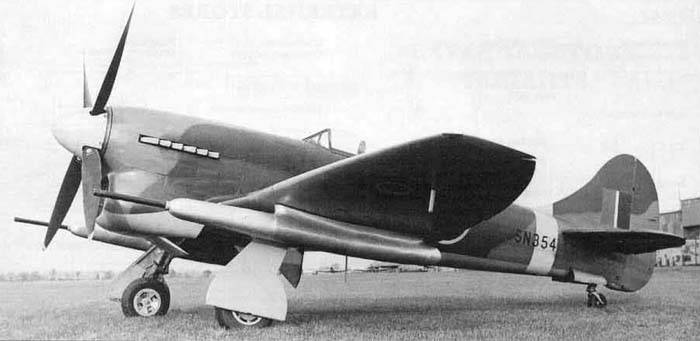
According to project data, an armor-piercing projectile weighing 2,07 kg, released at a speed of 808 m / s, was supposed to penetrate 75 mm armor. When using a tungsten core in the projectile, the armor penetration value was supposed to be increased to 100 mm. However, at the final stage of the war there was no special need for aircraft with such guns. It is known about the construction of one Tempest with 47-mm guns.
Due to the fact that the flight data of Tempest made it possible to perform the whole range of tasks and successfully conduct air combat with any German serial piston fighter, the use of this machine was more multifaceted compared to the Typhoon. Nevertheless, Tempests were widely used to combat armored vehicles and direct air support. By the beginning of 1945, combat squadrons already had about Tempest 700. About a third of them participated in strikes against ground targets.
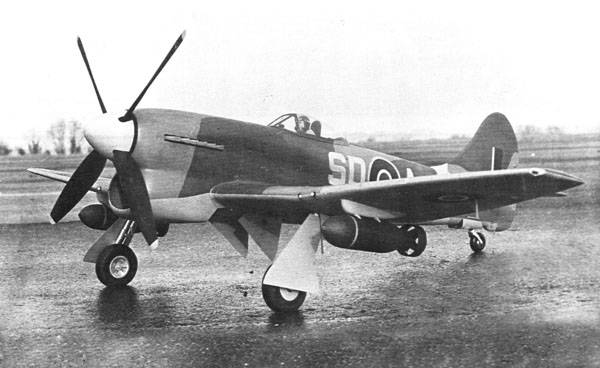
It is quite difficult to evaluate the effectiveness of the actions of British fighter-bombers against tanks. 152-mm heavy missiles are guaranteed to destroy or incapacitate in the event of hitting any German tank or SPG. But the effectiveness of the use of missiles is directly dependent on the qualifications and experience of the pilot. Usually during the attack, the British attack aircraft swooped at the target at an angle of up to 45 degrees. The steeper the dive angle was, the greater the accuracy of the launch of heavy NAR. After the target hit the reticle, just before launching, it was necessary to slightly raise the nose of the aircraft in order to take into account the downfall of the missiles. For inexperienced pilots, a recommendation was issued before launching missiles to carry out tracer shells. It was very common for British pilots to significantly overestimate their achievements in the fight against German armored vehicles. So, 7 August 1944, the Typhoon fighter-bombers during the day attacked the German tank units advancing to Normandy. According to the pilots reports, they destroyed 84 and damaged 56 tanks. However, later the British command found out that only 12 tanks and SPG were damaged and destroyed by missiles. However, in addition to the missiles, attack aircraft also dropped 113 and 227 kg bombs and fired at targets from cannons. Also among the burned and wrecked tanks there were a lot of armored personnel carriers and tracked tractor, which in the heat of battle could be mistaken for tanks or self-propelled guns.
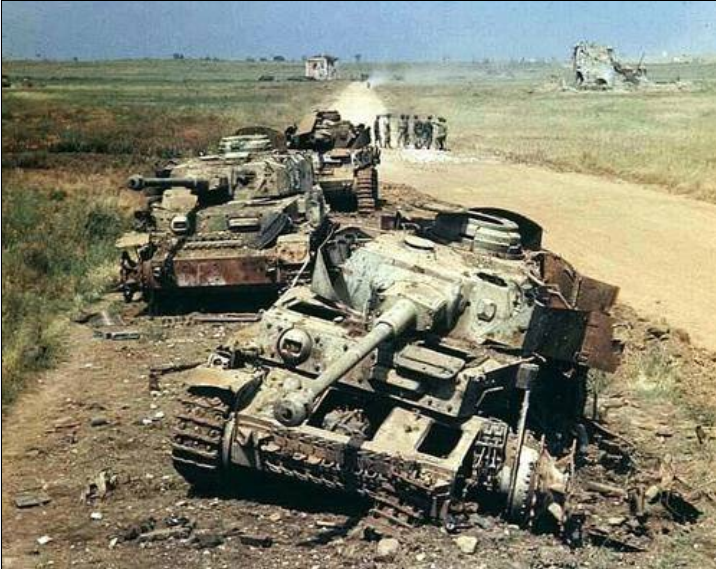
But in any case, the success of the Typhoon pilots was overestimated several times. Practice has shown that in reality, the high declared results of fighter-bomber should be treated with great care. Pilots were very peculiar not only to overstate their own success, but also the number of German tanks on the battlefield. According to the results of several detailed investigations carried out in order to ascertain the real combat effectiveness of the "Typhoons" and "Tempests", it was found that real achievements did not exceed, at best, 10% of the declared number of enemy tanks.
In contrast to the Royal Air Force, the US Air Force did not have squadrons specializing mainly in hunting for German armored vehicles. The American Mustangs and Thunderbolts, attracted for strikes at ground targets, acted upon requests from land-based aircraft navigators or engaged in “free hunting” in the near German rear or on communications. However, the missiles on the American warplanes were suspended even more often than in the British Air Force. The most common American NARs were shells of the M8 family - they were produced in millions of copies and were widely used in all theaters of operations. To launch NAR М8, tubular launchers with a length of about 3 m, made of plastic (36 kg weight), magnesium alloy (39 kg) or steel (86 kg) were used. In addition to the mass, the launch tubes differed in resource. The lightest, cheapest and most common plastic PU M10 had the lowest resource. Launch tubes were grouped into a bundle of three pieces under each wing of the fighter.
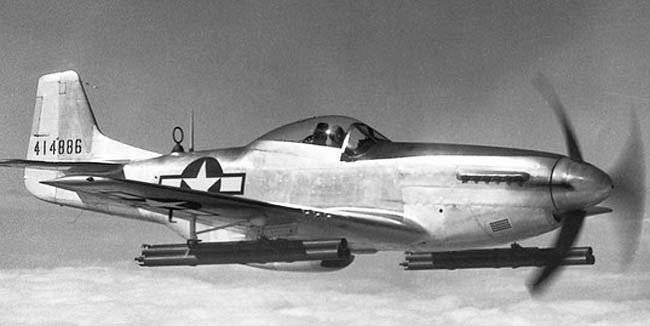
The design of the NAR M8 for its time was quite advanced, compared with the British RP-3 family of missiles - it is a much more advanced missile, characterized by reduced frontal resistance of launchers, good weight perfection and better shooting accuracy. This was achieved through a successful layout and the use of spring-loaded stabilizers, which were revealed when the missile exited the PU.
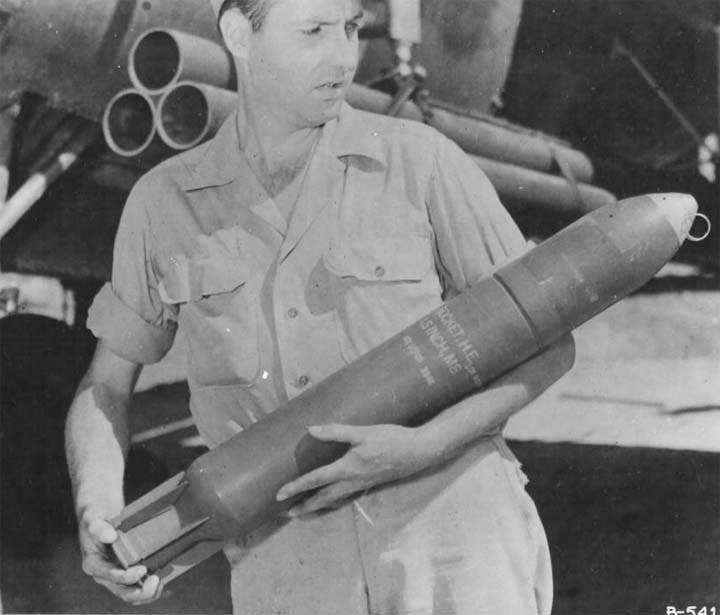
Uncontrolled aircraft rocket M8 in the hands of an American soldier in front of equipment in a tubular launcher
The 114-mm (4,5 in.) Missile M8 had a mass of 17,6 kg and a length of 911 mm. The engine containing 2,16 kg of solid fuel accelerated the rocket to 260 m / s. In practice, the speed of flight of the carrier was added to the rocket’s own speed. The high-explosive warhead contained 1,9 kg of TNT. In the case of a direct hit with a high-explosive warhead, she breached 25 mm armor. There was also an armor-piercing modification with a steel bar, which, with a direct hit, could penetrate 45 mm armor, but such missiles were rarely used. The combat use of the M8 missiles began in the spring of 1943. Initially, the P-8 Tomahawk fighter was the carrier of the M40 missiles, but later these NARs became very widespread and were used on single-engine and twin-engine American combat aircraft.
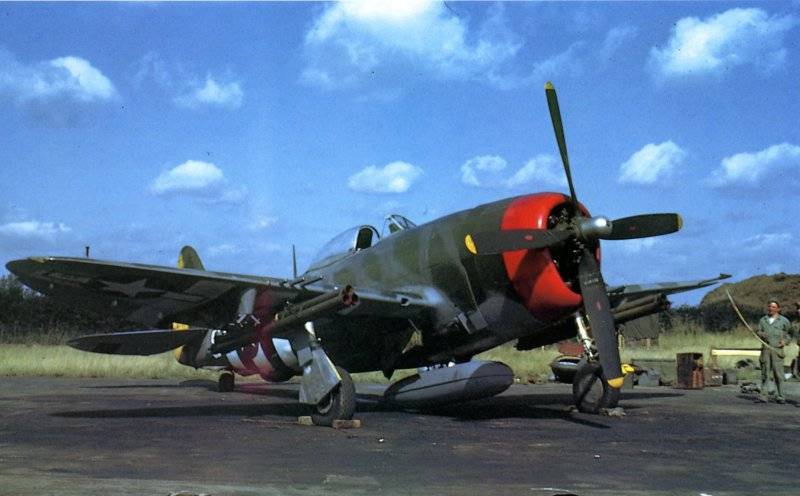
At the end of 1943, an improved model М8А2, and then А3 went into the series. On missiles of new versions in order to improve the stability of the trajectory, the area of folding stabilizers was increased, and the mass of explosives in the warhead increased to 2,1 kg. Thanks to the use of a new formulation of gunpowder, the thrust of the cruise missile engine was increased, which in turn had a beneficial effect on the accuracy and range of fire. Just before the start of the 1945, more than 2,5 million M8 missiles were produced. The scale of the combat use of NAR M8 in the US Air Force is evidenced by the fact that the Thunderbolt fighters of the 47 Air Army during the fighting in Italy spent up to 12 missiles daily.
Late modifications M8 had a good accuracy of fire, surpassing this indicator British missiles by about 2 times. But with actions on heavy armored vehicles and pillboxes, the destructive force of their warhead was not always enough. In this connection, 1944-mm NAR 127HVAR (High Velocity Aircraft Rocket - a high-speed aircraft rocket), created on the basis of 5 FFAR and 3,5 FFAR missiles used in naval aviation, entered production in 5. In aviation units, she received the informal name "Holy Moses" ("Holy Moses").
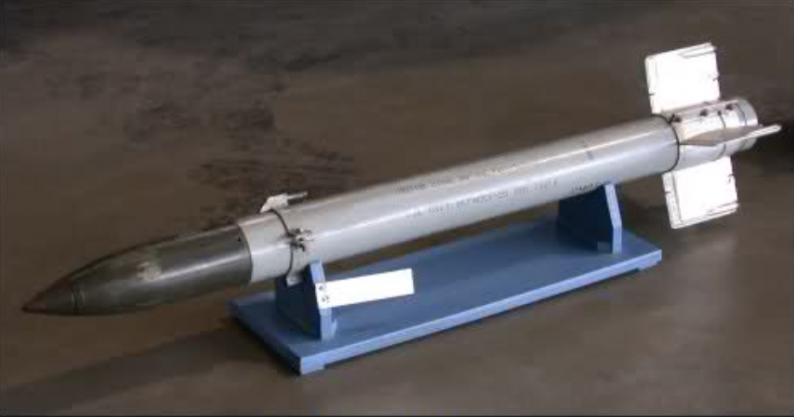
Due to the use of rocket fuel of complex composition with a high specific impulse consisting of: 51,5% nitrocellulose, 43% nitroglycerin, 3,25% diethyl phthalate, 1,25% potassium sulfate, 1% soot, the maximum speed of the rocket’s flight was reached up to XNXMHMXXMHMXXXXXXXXXXXXXXXXXxxxxxx without taking into account the speed of the aircraft carrier. The target launch range for point targets was 0,2 m, for area targets - up to 420 m. The 1000 rocket carried a 2000 kg warhead, which was loaded with 61 kg of Comp B-explosives - a mixture of TNT and hexogen. On tests 20,6-inch missiles managed to break through 3,4 mm naval cemented armor. Armor 5-57 mm thick could be punctured in the immediate vicinity of the explosion point by fragments. For 12-mm NAR also created a solid armor-piercing warhead with a carbide tip, despite the fact that such a missile was able to penetrate the frontal part of the "Tiger", she was not popular with her crew.
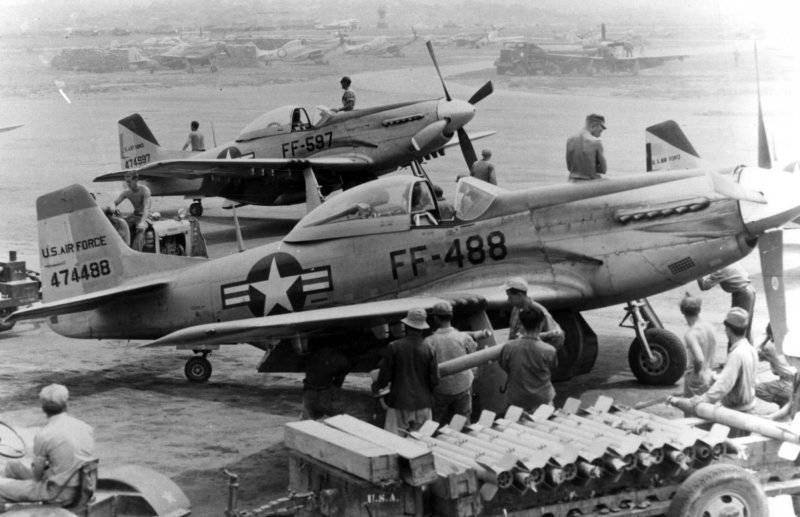
In terms of its operational and combat performance, the 127-mm 5HVAR has become the most advanced type of unguided aircraft missiles used by the Americans during the Second World War. Despite the fact that the cruciform cruciform stabilizers were used on this rocket, in accuracy of launch it was not inferior to the M8. The striking effect of 127-mm rockets was ample. With a direct hit in heavy and medium tanks, they were usually incapacitated. Uncontrolled aircraft 5HVAR missiles in the postwar period were widely used, in some countries remained in service until the beginning of the 90-s and used in many local conflicts.
In the part devoted to the anti-tank capabilities of the Allied aviation, it is not by chance that so much attention is paid to aviation unguided missiles, since they were the main means of fighting German armored vehicles. However, against the tanks, including on the battlefield, bombs were used quite often. Since the Americans and the British did not have anything like the Soviet PTAB, they were forced to use 113, 227 and even 454 kg bombs against single tanks. At the same time, in order to exclude the destruction of own bombs by shrapnel, it was necessary to severely limit the minimum discharge height or to use detonators with deceleration, which naturally had a negative effect on the accuracy of bombing. Also, from the middle of 1944 in Europe, single-engine strike aircraft began to suspend 625 liter napalm tanks, but they were used relatively infrequently.
In the comments to the second part of the cycle devoted to the combat effectiveness of Soviet attack aircraft, a number of visitors to the site rests on the "uselessness" of the IL-2. It has been argued that an airplane, in its characteristics close to the P-47, would have been a more effective attack aircraft on the Eastern Front than the armored Elahs. At the same time, discussion participants forget about the circumstances in which Soviet and American aviation had to fight. It is absolutely not correct to compare the conditions and aviation equipment of the Western and Eastern fronts. At least until the middle of 1943, our combat aircraft had no dominance in the air, and the attack aircraft constantly encountered the most severe anti-aircraft resistance from the Germans. By the time the Allies landed in Normandy, the main German flight crews were ground up on the Eastern Front or defended the sky of Germany from the destructive raids of heavy bombers. Even with fighters in the Luftwaffe, they were often unable to take to the air due to the chronic shortage of aviation gasoline. And the German anti-aircraft artillery on the Western Front in 1944 was not at all the same as, say, in 1942 in the East. There is nothing surprising that in these conditions the unarmored "Typhoons", "Tempests", "Thunderbolts" and "Mustangs" dominated the battlefield and pirated in the rear of the enemy. Here it came at an opportune time that the Thunderbolt had a large combat load (P-47D - 1134 kg) and a huge fighter-range flight range - 1400 km without PTB.
It was possible to bring the powerplant to mind, “lick” the structure and eliminate the “childhood sores” of the P-47 only a few months before the opening of the “Second Front”. After that, “Flying Jugs” became the main striking force of aviation support for the ground forces of the US Army on the battlefield. This was facilitated not only by a large combat radius of action and a commanding combat load, but also by a tenacious air-cooled engine covering the pilot in front. However, more maneuverable and high-speed "Mustangs" also often worked on the leading edge and acted on communications.
A typical tactic of American fighter-bombers was a sudden attack from a gentle dive. At the same time, during actions on columns, railway junctions, artillery positions and other targets behind the line of German defense, repeated combat visits in order to avoid losses from anti-aircraft fire, as a rule, were not carried out. American pilots, providing direct air support to their units, also tried to deliver "lightning strikes", after which they carried out care at low altitude. Thus, they did not “iron” the target, making several attacks, like IL-2, and, accordingly, the losses of the American attack aircraft from small-caliber anti-aircraft artillery were minimal. But even with such tactics, taking into account the total superiority of the Allies in the air and the number of fighter-bombers that depart daily for combat missions, it was impossible for the Germans to navigate the roads in the frontline in the daytime during the flying weather. Continuous air strikes also exposed any detected armored vehicles.
This is extremely demoralizing effect on the morale of German soldiers. The fear of raids by Anglo-American aviation even appeared among veterans who fought in North Africa and on the Eastern Front. As the Germans themselves said, on the Western Front they developed a “German look” - all German soldiers, without exception, who had spent several days on the Western Front, even away from the front line, constantly looked at the sky with anxiety. A survey of German prisoners of war confirmed the enormous psychological effect of air attacks, especially missile ones, even tank crews consisting of veterans were exposed to it. Often, tankers left their combat vehicles, only noticing the approaching attack aircraft.
Here is what the commander of the 3 tank battalion of the 67 tank regiment, Colonel Wilson Collins, wrote about this in his report:
In general, the effectiveness of air attacks during actions against tanks among the pilots of the Mustangs and Thunderbolts was about the same as in British aviation. Thus, in ideal conditions of the landfill, in the motionless captured tank PzKpfw V, with the launch of the 64, the NAR M8 managed to achieve five direct hits. No better deal with the accuracy of the missiles were on the battlefield. So, during the inspection of the destroyed and destroyed German armored vehicles at the battle site in the Ardennes, all 6 tanks and SPGs were hit with missiles, although the pilots claimed that they were able to make hits on the 66 armored vehicles. When attacking a tank column of about fifty tanks, on the highway in the vicinity of La Baleyn in France, it was announced the destruction of 17 units. During the survey, the site of the air strike on the spot found only 9 tanks, and only two of them could not be restored.
Thus, it can be stated that the Allied fighter-bombers didn’t exceed the Soviet armored IL-2 attack aircraft in their effectiveness. However, literally all the Allied combat aircraft that flew during the daytime acted against armored vehicles. Many cases are known when dozens of B-17 and B-24 heavy bombers were involved in the bombing of German tank units. Given that the Americans in 1944 had superiority in the air and a huge number of bombers at their disposal, they could not afford to use strategic bomber aircraft to accomplish tactical tasks. Of course, four-engine bombers dropping 227, 454 and 908 kg bombs as an adequate anti-tank weapon can be considered a stretch, but the probability theory and the “magic of big numbers” come into play. If hundreds of heavy bombs fall from a height of several kilometers onto a limited area, they inevitably cover someone. After such air raids, even the surviving crews in serviceable tanks, due to the strongest moral shock, often lost their combat capability.
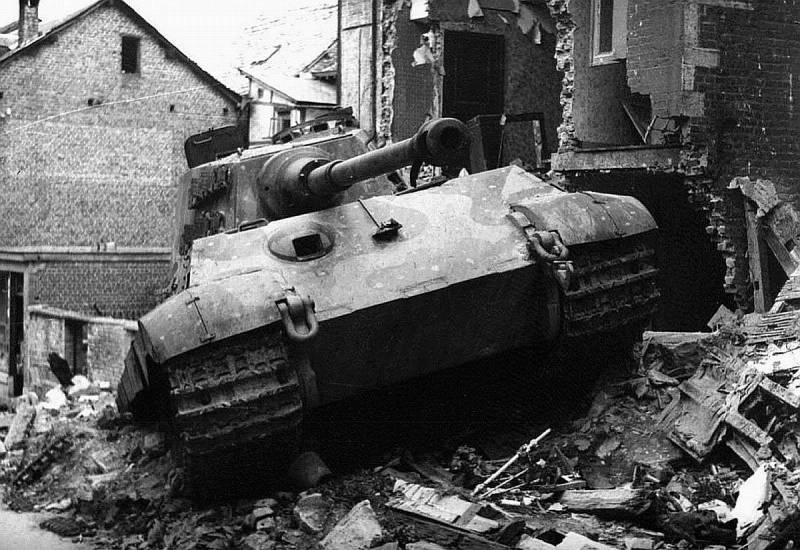
In France, the Netherlands and Belgium, the Allies avoided mass bombing of populated areas, but after the fighting spread to the territory of Germany, the tanks could no longer hide among the residential areas.
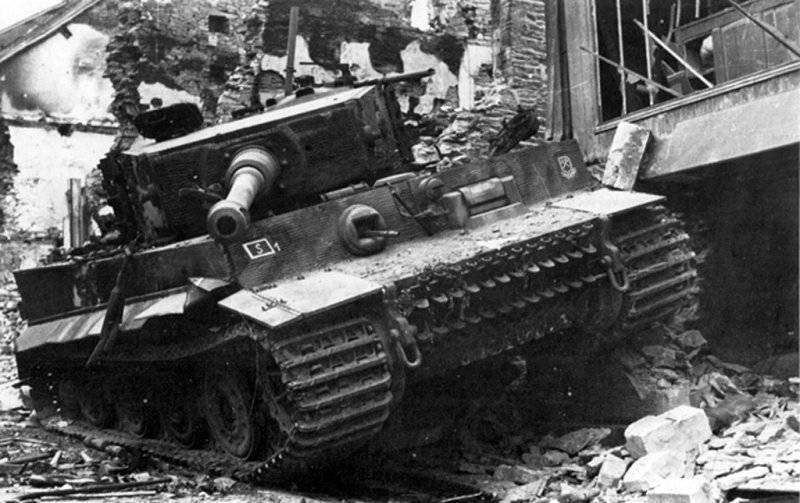
Despite the fact that in the arsenal of aviation weapons of the Americans and the British there was not enough effective anti-tank weapons, they were able to successfully hold down the actions of the German tank units, depriving them of the supply of fuel and ammunition. After the Allies landed in Normandy, the enemy’s railway network was completely destroyed and the German armored vehicles that accompanied its trucks with shells and supplies, fuel trucks, infantry and artillery were forced to make long marches on the roads, while being subjected to continuous air traffic. After the liberation of France, many commanders of the Allied units complained that the narrow roads leading to Normandy were cluttered with broken and broken German vehicles in 1944, and it was very difficult to travel around them. As a result, a significant part of German tanks simply did not reach the front line, and those who got there were left without fuel and ammunition. According to the memoirs of the surviving German tankers who fought in the West, they were often forced to abandon, not being able to timely repair, not only equipment that received minor military damage or had minor damage, but also absolutely serviceable tanks with dry fuel tanks.
Продолжение следует ...
Based on:
http://www.quarryhs.co.uk/Pgun.htm
http://www.airpages.ru/us/b25h.shtml
http://www.airwar.ru/enc/aww2/a36.html
http://ftr.wot-news.com/2014/04/04/ground-attack-aircraft-myth-of-the-tank-busters/
http://www.designation-systems.net/
Jaap Teeuwen. British Aircraft of World War II
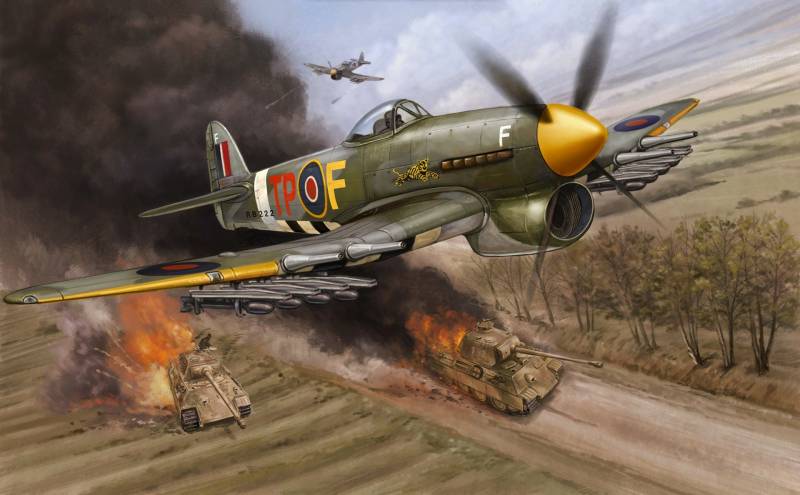
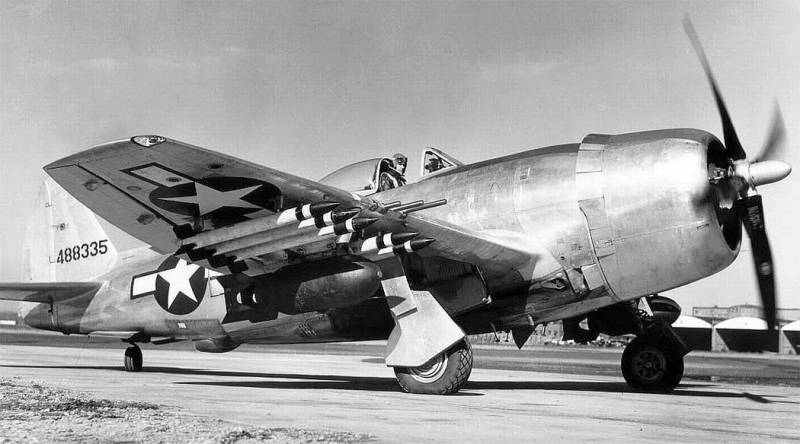
Information